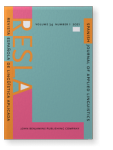Vol. 34:1 (2021) ► pp.171–200
Vol. 34:1 (2021) ► pp.171–200
Modality across genres in Spanish as a heritage language
Writers’ use of modality, an interpersonal linguistic resource commonly used for expressing probability, reveals key information about their claims. Most research on modality addresses L2 English learners, leaving a gap in research in advanced language development in other languages. This paper addresses this gap by studying how heritage language (HL) speakers of Spanish express doubt and probability in Spanish and how the lexicogrammatical features they use across genres reveal how they express these meanings. Drawing on Systemic Functional Linguistics and pragmatics, this study examines modality in 125 texts written in Spanish by HL students in the U.S., including narratives, expositions, article reviews, personal responses, and research papers. The results reveal that students use the most modality resources in personal responses and the least in reviews. This work offers insights about the interpersonal resources writers choose to express their argumentative stance and the socio-pragmatic competence in writing among HL students.
Article outline
- 1.Introduction
- 1.1Modality and language acquisition
- 1.2Heritage language and writing
- 1.3Systemic functional linguistics and academic genres
- 1.4The present study
- 2.Methods
- 2.1Genre and register of texts
- 2.2Self-reported language skills
- 3.Modality devices across genres
- 3.1Conditional and subjunctive forms
- 3.2Adverbial, adjectival, and other phrasal adjuncts
- 3.3Bushes and hedges
- 3.4Modal verbs
- 4.Discussion
- Acknowledgements
- Notes
-
References
